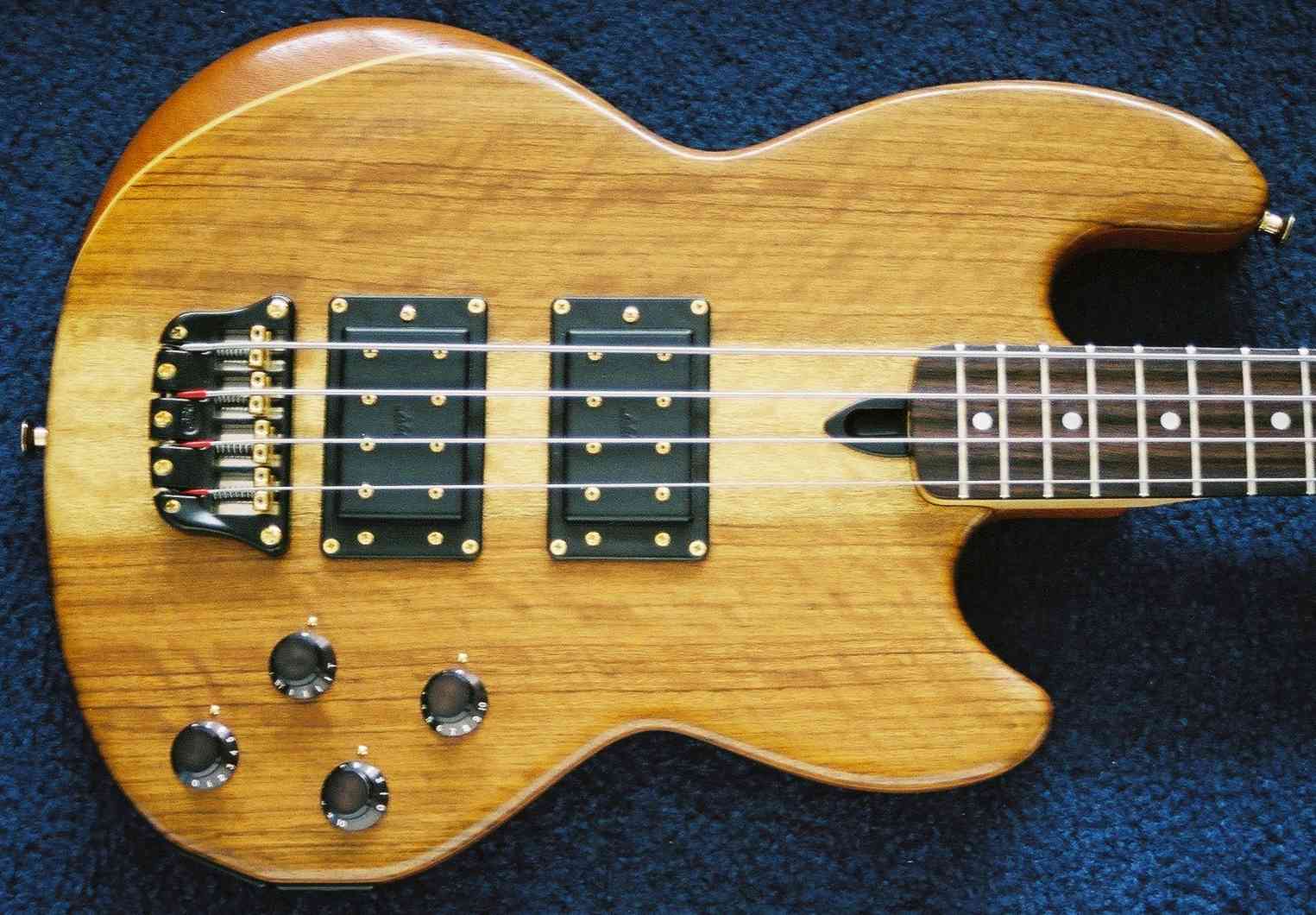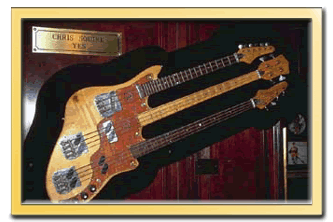


Wal bass specifications
Apologies to those viewing on low bandwidth services. This page is rather image heavy and may take a short while to fully download...
Wal Pro bass specifications



Pro bass headstocks




The Pro Series headstocks are characterised by the striking neck laminates which continue through the headstock. Early Pro headstocks featured 10 laminations of maple, mukalungu (an Amazonian hardwood) and English hornbeam. In later Pro basses the (purely decorative) outer mukalungu laminates were dispensed with to create an 8 way lamination.
 Pro
I body shape and pick-up placement
Pro
I body shape and pick-up placement
Pro bass general specs: Solid ash body; maple, mukalungu and hornbeam laminated neck, 21 frets, rosewood fingerboard.
Pro I - one passive pickup, series/parallel switching
Pro II - two passive pickups, series/parallel switching
Pro IE - one active pickup, pick attack switch, low-mid boost switch
Pro IIE - two active pickups, pick attack switch, low-mid boost switch for neck pickup, upper-mid boost/bass cut switch
Controls: Master volume control (Pro II and Pro IIE), individual volume and tone controls for each pickup. Chrome hardware with optional XLR output, pickup selector switch (Pro II and Pro IIE).


Pro IIE body shape including scratchplate and contouring
Wal Custom bass specifications
Wal Mk I Custom Series bass with schedua facings


Mk I body rear contouring

Laminated offset waist, twin cutaway body in three body styles - Mark I (21 fret 4 string), Mark II (24 fret 4 & 5 string), Mark III (24 fret 4, 5 & 6 string). Mahogany core with exotic wood facings. Maple, Amazonian hardwood and hornbeam laminated neck, 21 or 24 frets, rosewood or ebony fretted or fretless fingerboard.
Chrome or gold plated fittings (black anodised small tuning pegs as an option).
Electronics and controls - from Wal Custom Bass flyer
"ELECTRONIC FEATURES
WAL flat response, humbucking pick-ups; moulded in black ABS. with three
point, spring mounted, height adjustment. These pick-ups contain four individual
string- matched pick-ups, thus virtually eliminating imbalances, crosstalk and
inter-modulation. Plated pole-pieces are adjustable with socket screwdriver
provided.
WAL printed circuit electronic modules use high stability, closest tolerance
components and graphite wiper pots, with push/pull gold contact switches. All
controls are designed for ultra low noise, interference and distortion-free
performance. Powered by a single 9-volt PP3 size battery, consumption is less
than (1mA).
Balanced DI and transformer isolation provides clean, reliable and safe studio or stage mixer feed without the need for an external DI box.
Standard 1/4" jack output for amplifier feed. Insertion into this socket switches on electronics. A dummy or unconnected jack plug MUST be inserted when using DI output alone.
Pick-ups, P.C. Modules and output sockets are all interconnected via shake-proof, polarized connectors for easy removal and replacement. All cavities are screened against external electrical interference.
CONTROLS
Volume Knob:- rotary adjustment of output volume, pull to actuate pick-attack. A narrow band of high frequencies is added to the overall tone-setting to provide dynamic, percussive attack. Both overall output level and level of pick-attack are trimmable from inside the bass.
Pick-up Mixing Knob:- This silently mixes the levels of the pre-EQ'd pick-ups to any desired ratio whilst keeping the combined output level constant.
Tone-Knobs:- These operate electronic, low pass filters whose roll-off frequencies vary with the position of the control. Fully clockwise at 10, the spectrum is full and flat. As the controls are backed off, the spectrums of the appropriate pick-ups are foreshortened. (Roll-off 12dB / Octave). The dominant tone character varies, therefore, throughout the entire range of control. Pulling-up the knob produces a quasi-parametric boost of about 10dB to the harmonics which lie at or near the roll-off frequency set by the rotary position. This provides the characteristic active sounds so popular today, without the clinical quality common to many circuits. By using the pan mixer like a master tone control, in conjunction with the pick-up controls, an endless range of subtle tones and dynamic effects can be created, with or without the pick attack.
On left-hand models all rotary functions are reversed to right-hand."
Original shape "Custom series" 4-string and 5-string headstocks



Mk I four-string bass and Mk II four and five-string basses



Mk III four, five and six-string basses



"Standard" wood options
(left to right - American walnut, Wenge, Paduak, Schedua)




American Walnut (Juglans nigra - also known as black walnut): The heartwood is a light chocolate brown and varies from relatively plain to quite heavily figured (usually with swirling patterns rather than quilting or flaming). Pete considers that this wood is the best choice for a fretless bass, giving the best fretless tone.

Wenge (Millettia Laurentii): A very dark, dense wood, usually with a fine straight grain. However some interestingly figured examples can be found. Considered by many to give the hardest, punchiest of Wal tones. For an example of a more figured Wenge-faced Wal bass see picture on right.
Paduak (Pterocarpus soyauxii): The heartwood of paduak is characteristically reddish in colour, varying to a dark, chocolate brown and usually with a straight grain. The sap wood is very pale in colour and is sometimes used as a contrasting, book-matched centre stripe on Wals (see example above).
Schedua (Guibourtia Ehie): In some ways the "standard" Wal wood, schedua (also written "shedua" and "hydua") is a rich golden brown colour. The sapwood is a much paler colour and, as with paduak, is sometimes used to create a bookmatched central pale stripe on the facings. However, the difference in colour between heartwood and sapwood is more subtle with schedua than paduak. Schedua is also commonly known as "ovangkol" or "amazaque" and comes from the same botanical family as "bubinga". Schedua often displays a unique form of flaming which can vary from fine and subtle patterns to the wild flame shapes shown above.
Some useful links to information resources on woods used in instrument building:
http://www.exotichardwoods-northamerica.com/index.htm
http://delta-intkey.com/wood/english/
http://www.bluebookinc.com/staticinfo/bluebookinc/PDF/AGuitar/AKnowYourWood.pdf
Wal custom built basses, rarities & oddities


Steve Chesney's custom "36 fret" fretless Wal custom bass with burled redwood top and matching headstock facing.
1990 reissue passive, single-pickup "Pro-type" bass




Mark I Custom bass with birds-eye maple top but also with almost symmetrical horns (reminiscent of the original Wal bass, W1111 built for John G Perry). Age of bass uncertain.

The first ever Wal bass (W1111) - built for Caravan & Quantum Jump basss player John G Perry

 John
G Perry pictured at Redan Recorders, London recording a session for Gordon
Giltrap's "Fear of the Dark" album in 1978 and in Wal Pro Series promotional
literature
John
G Perry pictured at Redan Recorders, London recording a session for Gordon
Giltrap's "Fear of the Dark" album in 1978 and in Wal Pro Series promotional
literature
 The famous Chris Squire triple neck Wal (this photo is actually of a replica!).
The famous Chris Squire triple neck Wal (this photo is actually of a replica!).

Original Wal Triple Neck at the Hard Rock Cafe, New York, USA (note difference in centre neck pickup surround).
JG Custom bass belonging to JG himself! John Gustafson

 John
Gustafson using his JG Custom bass live with the Gordon Giltrap Band in 1978
John
Gustafson using his JG Custom bass live with the Gordon Giltrap Band in 1978
The JG Custom Series basses are similar in specification to the Pro Series Basses which followed them (solid ash body and laminated neck). However, the JG Custom basses feature the distinctive leather scratchplates (not all are tooled with the floral patterns - some are plain) common to early Wals. Scratchplates on the Pro Series were plastic mounted on a metal backing plate. On the JG Custom Series basses the tone shaping switches were mounted on the pickup surrounds rather than the scratchplate (as on the Pro series). Most JG Customs also featured a decorative maple headstock facing.
Only around 28 JG Customs were made.
John Gustafson



Double neck - solid walnut body, fretted and fretless necks, ebony fingerboards.



Wal bass price-lists
Text: Trevor Raggatt © 2004